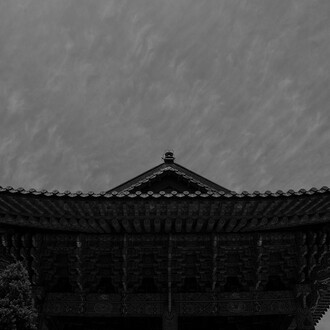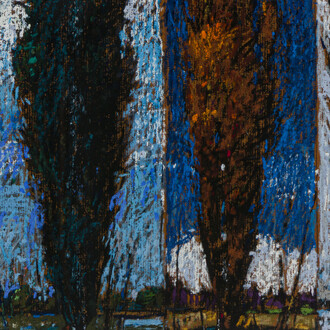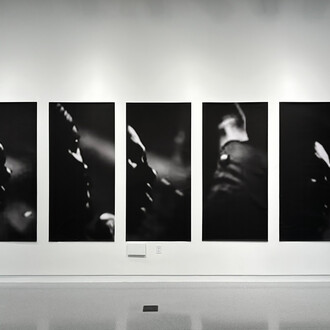Fergus McCaffrey is pleased to present Japan Is America, an exhibition exploring the complex artistic networks that informed avant-garde art in Japan and America between 1952 and 1985. Starting with the well-documented emergence of “American-Style Painting” that ran parallel to the Americanization of Japan in the 1950s, Japan Is America endeavors to illustrate the path and conditions from Japanese surrender in 1945 to that country's putative cultural take-over of the United States some forty years later. The exhibition traces the international exchanges that supported and propelled Japanese art forward in unimaginable ways, and shifted the course of American art and culture. The exhibition will be accompanied by an ambitious film program including rarely-seen films by John Cage, Shigeko Kubota, and Fujiko Nakaya, among others.
In the aftermath of World War II, both countries sought recognition beyond the cultural periphery, carving out a space for the redefinition of aesthetics in the post-war era. After 1945, Japan focused on rebuilding, countering the devastation of their defeat in World War II. The nation was occupied by American forces between 1945 and 1952. Sentiments of democracy and peace resonated throughout Japan, but art from the region reflected upon and responded to the death and suffering experienced.
Japan Is America begins with Tatsuo Ikeda’s kinukosuri portrait of an American soldier’s wife from 1952. The photorealistic painting, produced from a snapshot, illustrates an innovative business model aimed at the troops occupying American military bases in Japan during the Korean War. Amongst the first foreign consumers of Abstract Expressionism in the Japanese art scene was Gutai Art Association (1954–72) in Osaka, led by Jirō Yoshihara. Harnessing Japan’s unprecedented Western-style societal freedom and aspirations, Yoshihara encouraged his understudies to seek out new ways of art-making and international cultural exchange. Gutai in the 1950s developed in opposition to “conventional formalism,” seeking “a new autonomous space…a space previously unknown, unseen, and unexperienced.”
In Tokyo, the Sōgetsu Art Center (1958-71) became a leading space for experimental practices in visual and performance arts, and a hub for international exchanges between Japanese and American artists. In the early 1960s, the Center invited John Cage, David Tudor, Merce Cunningham and Robert Rauschenberg to Japan, subsequently holding performances and lectures the following years. A swell of artist collectives in Japan arose after World War II, including the Neo-Dadaism Organizers (1960) and Hi-Red Center (1963-64). With a tenet of “Anti-Art,” coined by the critic Yoshiaki Tōno, radical artists that participated in the annual Yomiuri Independent exhibitions (1949–63) redefined realism beyond representation by using commonplace items and detritus in more performative and object-oriented art-making practices.
After the ratification of the ANPO Treaty in 1960—effectively allowing the United States to interfere with any conflict in East Asia that might affect Japan—, the extremes of democracy and imperialism were unmistakable. Amid Japan’s rapid transformation concurrent with, and proceeding, the 1964 Summer Olympics in Tokyo and America’s billowing involvement in the Vietnam War, artists in both nations continued to engage in radical individualism in the 1970s.
Marking 25 years after the end of World War II, the Expo ’70 in Osaka, the first World’s Fair held in Japan, was a reflection of the country’s postwar resurgence. Known for its experimental architecture, cultural innovation, and futuristic technologies, the exposition foreshadowed the country’s imminent greatness on the world stage. Fujiko Nakaya, the Tokyo representative for the American art collective Experiments in Art and Technology (E.A.T.), sponsored by Bell Laboratories, debuted the world’s first atmospheric fog sculpture for the Pepsi Pavilion at Expo ’70. The same year, Tokyo Biennale ’70: Between Man and Matter, the 10th International Art Exhibition of Japan, opened, offering insight into sculptural, conceptual, and performative innovation around the world with works by Richard Serra, Carl Andre, Sol LeWitt, and a multitude of local, underrepresented Japanese conceptual artists including Jiro Takamatsu and Hitoshi Nomura. The exhibition subsequently traveled to several major cities in Japan, and was later featured in Lucy Lippard's book, Six Years: The Dematerialization of the Art Object from 1966 to 1972 (1973).
Conceptual art, spearheaded by the Mono-ha group of artists dedicated to "not-making," exploded in Japan after the Biennale, spurring Japanese critics like Takashi Hayami to consider how artists could "transform Art or the concept of Art" without the material constraints of painting and sculpture. These interactions supported curiosity and confidence in both directions, with new developments emerging from interchange and strong long-distance relationships. The avant-garde impulses in both Japan and America were capped in the 1980s when mass-media, gross materialism, and celebrity signaled yet another shift in contemporary art.
By the mid-1980s, Japan’s presence resonated in the United States as it had achieved cultural and economic equality with the most powerful country in the world. Its widespread takeover was felt across America, initiating a diversity of reactions. The exhibition is bookended with Ed Ruscha’s recent Japan Is America drawing, signaling the artist’s initial response to Japan’s extraordinary postwar recovery in 1985, and the construction of a wealthy, modern, and peaceful society.
















